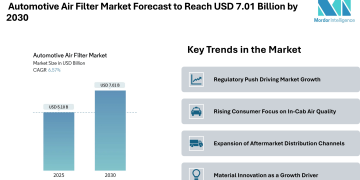Introduction
The automotive air filtration market size stands at USD 5.10 billion in 2025 and is forecast to reach USD 7.01 billion by 2030, advancing at a 6.57% CAGR.
Rising global vehicle ownership and aging fleets are driving demand for automotive air filters from both OEMs and the aftermarket. Understanding the market share between these segments is key for stakeholders to track growth and remain competitive.
Key Market Trends
Regulatory Push Driving Market Growth
One of the strongest automotive air filter market trends is the tightening of emission and air-quality regulations across Europe, North America, and Asia Pacific. OEMs are increasingly specifying high-efficiency particulate filters (HEPA) and nano-fiber materials to comply with Euro 7 and other regional standards. This regulatory emphasis is fueling demand not just for standard intake filters but also for premium cabin filters and advanced filtration media.
Rising Consumer Focus on In-Cab Air Quality
Consumer awareness around in-cab air quality and health is growing, particularly in urban areas with high pollution levels. Vehicle owners are requesting better cabin filtration systems, which is boosting the market size for the cabin-filter segment and increasing the market share of higher-performance filtration media.
Expansion of Aftermarket Distribution Channels
While OEM fitment remains substantial, ageing vehicle fleets and longer service intervals are driving the aftermarket segment. Suppliers are offering premium replacement filters, bundled service kits, and digital maintenance support. This shift is altering the dynamics of automotive air filter distribution and expanding the aftermarket’s presence.
Material Innovation as a Growth Driver
Material innovation is becoming a key driver for market growth. Traditional cellulose media continue to dominate revenue share, but synthetic and nano-fiber media are experiencing faster growth and gaining global traction. These advanced materials support superior filtration performance, positioning automotive filters as a value-added component rather than a mere commodity.
Check out more details and stay updated with the latest industry trends, including the Japanese version for localized insights:
Market Segmentation
By Product Type
- Hybrid / Electrostatic Nano-fiber Filters
- Electrically-enhanced (ePM1) Filters
By Filter Media
- Activated-Carbon Composite
By Vehicle Type
- Light Commercial Vehicles
- Medium and Heavy Commercial Vehicles
By Sales Channel
By Geography
Key Players
Conclusion
The automotive air filter market is set for steady growth as regulatory pressures, consumer health concerns and material innovation combine to drive demand. With the market size projected to reach USD 7.01 billion by 2030, stakeholders across OEMs, filter manufacturers and aftermarket distributors should be prepared for expansion in cabin-filter segments, premium media adoption and shifting channel dynamics. The segmentation by product type, media type, vehicle type and sales channel offers a roadmap for prioritising high-potential areas of the automotive air filter market growth. Furthermore, companies with strong technology, global reach and aftermarket access are well-positioned within the automotive air filter market Share framework. In the coming period, monitoring the evolving regulatory environment, regional consumption patterns and filter-media innovation will be essential to fully capture market opportunities and align strategies within the automotive air filter market landscape.
Industry Related Reports
United States Automotive Air Filters Market: The United States automotive air filters market is segmented by material type, including paper and synthetic; filter type, covering intake filters (such as cellulose) and cabin filters (such as particulate); vehicle type, including passenger cars and light commercial vehicles; sales channel, including OEM and aftermarket; and distribution channel, such as online retailers. Market forecasts are provided in terms of value (USD).
South Korea Automotive Airfilters Market: The South Korea Automotive Air Filters Market is segmented by material type including paper, gauze, foam, and other air filters by filter type, comprising intake and cabin filters, by vehicle type, covering passenger cars and commercial vehicles, and by sales channel, including OEMs and the aftermarket.
North America Automotive Airfilters Market: The North America Automotive Air Filters Market is segmented by material type (Paper/Cellulose, Synthetic Gauze/Cotton, and others), filter type (Intake and Cabin), vehicle type (Passenger Cars, Light Commercial Vehicles, etc.), sales channel (OEMs and Aftermarket), and country (United States, Canada, and Mexico). Market forecasts are provided in terms of both value (USD) and volume (units).
About Mordor Intelligence:
Mordor Intelligence is a trusted partner for businesses seeking comprehensive and actionable market intelligence. Our global reach, expert team, and tailored solutions empower organizations and individuals to make informed decisions, navigate complex markets, and achieve their strategic goals.
With a team of over 550 domain experts and on-ground specialists spanning 150+ countries, Mordor Intelligence possesses a unique understanding of the global business landscape. This expertise translates into comprehensive syndicated and custom research reports covering a wide spectrum of industries, including aerospace & defense, agriculture, animal nutrition and wellness, automation, automotive, chemicals & materials, consumer goods & services, electronics, energy & power, financial services, food & beverages, healthcare, hospitality & tourism, information & communications technology, investment opportunities, and logistics.
For any inquiries or to access the full report, please contact:
media@mordorintelligence.com
https://www.mordorintelligence.com/






















